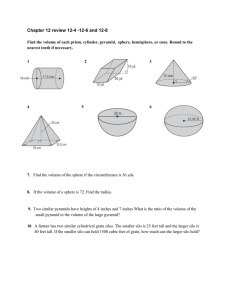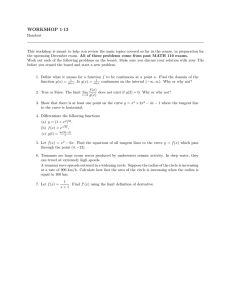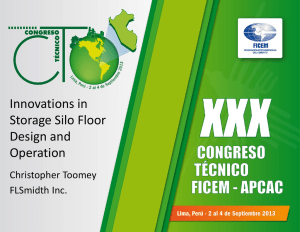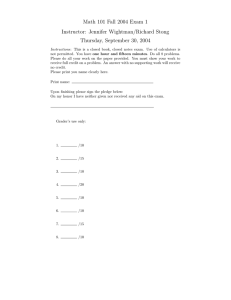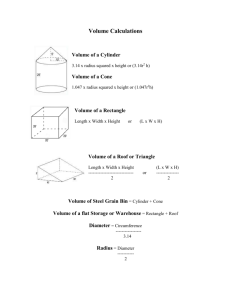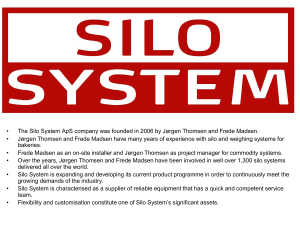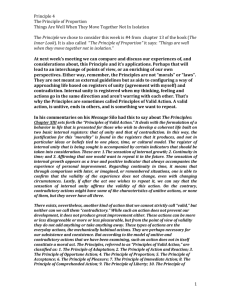International Journal of Application or Innovation in Engineering & Management...
advertisement
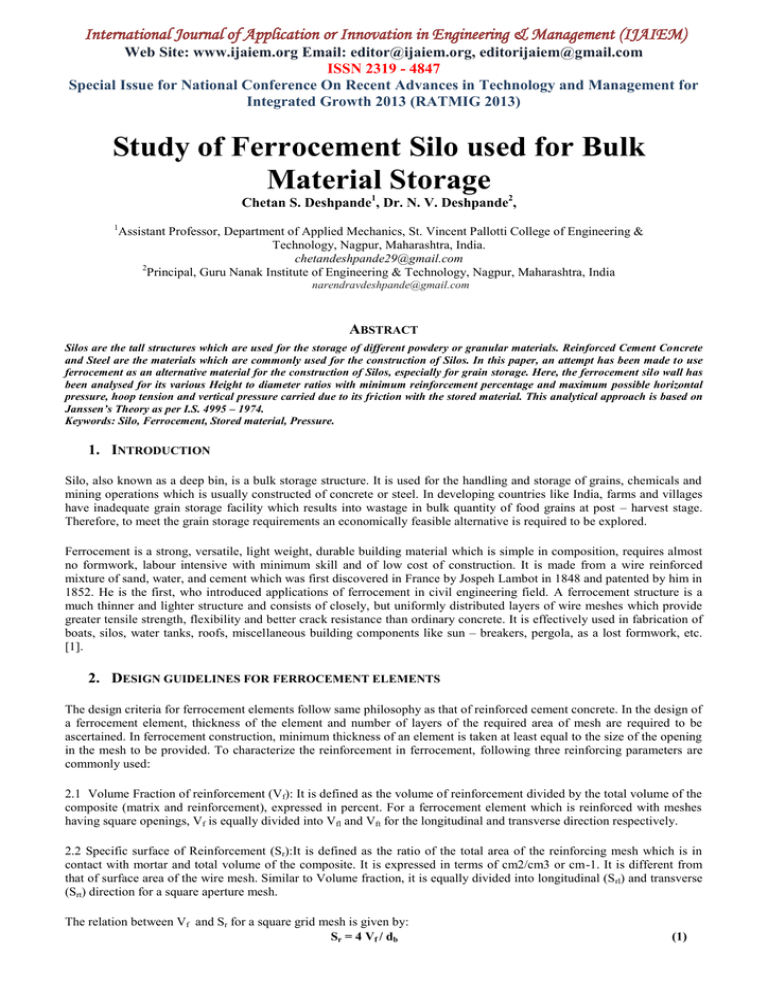
International Journal of Application or Innovation in Engineering & Management (IJAIEM)
Web Site: www.ijaiem.org Email: editor@ijaiem.org, editorijaiem@gmail.com
ISSN 2319 - 4847
Special Issue for National Conference On Recent Advances in Technology and Management for
Integrated Growth 2013 (RATMIG 2013)
Study of Ferrocement Silo used for Bulk
Material Storage
Chetan S. Deshpande1, Dr. N. V. Deshpande2,
1
Assistant Professor, Department of Applied Mechanics, St. Vincent Pallotti College of Engineering &
Technology, Nagpur, Maharashtra, India.
chetandeshpande29@gmail.com
2
Principal, Guru Nanak Institute of Engineering & Technology, Nagpur, Maharashtra, India
narendravdeshpande@gmail.com
ABSTRACT
Silos are the tall structures which are used for the storage of different powdery or granular materials. Reinforced Cement Concrete
and Steel are the materials which are commonly used for the construction of Silos. In this paper, an attempt has been made to use
ferrocement as an alternative material for the construction of Silos, especially for grain storage. Here, the ferrocement silo wall has
been analysed for its various Height to diameter ratios with minimum reinforcement percentage and maximum possible horizontal
pressure, hoop tension and vertical pressure carried due to its friction with the stored material. This analytical approach is based on
Janssen’s Theory as per I.S. 4995 – 1974.
Keywords: Silo, Ferrocement, Stored material, Pressure.
1. INTRODUCTION
Silo, also known as a deep bin, is a bulk storage structure. It is used for the handling and storage of grains, chemicals and
mining operations which is usually constructed of concrete or steel. In developing countries like India, farms and villages
have inadequate grain storage facility which results into wastage in bulk quantity of food grains at post – harvest stage.
Therefore, to meet the grain storage requirements an economically feasible alternative is required to be explored.
Ferrocement is a strong, versatile, light weight, durable building material which is simple in composition, requires almost
no formwork, labour intensive with minimum skill and of low cost of construction. It is made from a wire reinforced
mixture of sand, water, and cement which was first discovered in France by Jospeh Lambot in 1848 and patented by him in
1852. He is the first, who introduced applications of ferrocement in civil engineering field. A ferrocement structure is a
much thinner and lighter structure and consists of closely, but uniformly distributed layers of wire meshes which provide
greater tensile strength, flexibility and better crack resistance than ordinary concrete. It is effectively used in fabrication of
boats, silos, water tanks, roofs, miscellaneous building components like sun – breakers, pergola, as a lost formwork, etc.
[1].
2. DESIGN GUIDELINES FOR FERROCEMENT ELEMENTS
The design criteria for ferrocement elements follow same philosophy as that of reinforced cement concrete. In the design of
a ferrocement element, thickness of the element and number of layers of the required area of mesh are required to be
ascertained. In ferrocement construction, minimum thickness of an element is taken at least equal to the size of the opening
in the mesh to be provided. To characterize the reinforcement in ferrocement, following three reinforcing parameters are
commonly used:
2.1 Volume Fraction of reinforcement (Vf): It is defined as the volume of reinforcement divided by the total volume of the
composite (matrix and reinforcement), expressed in percent. For a ferrocement element which is reinforced with meshes
having square openings, Vf is equally divided into Vfl and Vft for the longitudinal and transverse direction respectively.
2.2 Specific surface of Reinforcement (Sr):It is defined as the ratio of the total area of the reinforcing mesh which is in
contact with mortar and total volume of the composite. It is expressed in terms of cm2/cm3 or cm-1. It is different from
that of surface area of the wire mesh. Similar to Volume fraction, it is equally divided into longitudinal (S rl) and transverse
(Srt) direction for a square aperture mesh.
The relation between Vf and Sr for a square grid mesh is given by:
Sr = 4 Vf / db
(1)
International Journal of Application or Innovation in Engineering & Management (IJAIEM)
Web Site: www.ijaiem.org Email: editor@ijaiem.org, editorijaiem@gmail.com
ISSN 2319 - 4847
Special Issue for National Conference On Recent Advances in Technology and Management for
Integrated Growth 2013 (RATMIG 2013)
For non- pre-stressed, non water retaining structures, the total volume fraction of steel mesh reinforcement should not be
less than about 1.8 % and the total specific surface of reinforcement should not be less than about 0.80 cm 2/cm3[2]. It is
tentatively recommended that for a given ferrocement element, without skeleton reinforcement, the number of layers of
mesh should preferably be such that
n ≥ 4 t (t in inches)
(2)
Or
n ≥ 0.16 t (t in mm)
(3)
In case, if skeleton steel is used in ferrocement, it is recommended that it should not occupy more than 50% of the
thickness of the element. Thus, if t’ is the thickness of the ferrocement element in which the mesh layers are distributed,
the number of layers of mesh should preferably be such that
n ≥ 4 t’ (t’ in inches)
Or
n ≥ 0.16 t’ (t’ in mm)
(4)
(5)
In the design of ferrocement elements, there are two approaches which are followed:
1) Ultimate Stress Design (USD) or Limit State Design (LSD) or Load & Resistance Factor Design (LRFD),
2) Working Stress Design (WSD) or Allowable Stress Design (ASD).
When the mesh wires are drawn from steel, the maximum allowable tension in the reinforcement under bending and axial
loads shall be 0.60fy or 400 MPa, whichever is smaller, whereas maximum allowable compressive strength in the mortar
matrix shall be 0.45fc’[2]. Also, the maximum permissible crack width is 0.005 cm [1]
3. DESIGN GUIDELINES FOR SILOS
For the design of silos, IS: 4995 (I):1974 & IS: 4995 (II):1974 which are based on Janssen’s theory have been referred.
There are three different kinds of loads which are caused by a material stored in a silo [3]
3.1 Horizontal load or horizontal pressure (P h) acting on the side walls of a silo.
3.2 Vertical load or vertical pressure (Pv) acting on the cross-sectional area of the bin filling,
3.3 Friction wall load or frictional wall pressure (P w) introduced into silo walls through wall friction.
Pw
Ph
Pv
Figure 1 Bin Loads
The maximum horizontal pressure on the silo walls, vertical pressure on the plan area of the circular silo and the vertical
pressure transferred to the walls through friction have been calculated using the following expressions as mentioned in
Janssen’s theory.
Horizontal pressure during Filling,
Ph = (wr/µf)[1 – e- (µf
λ H/r)
]
f
(6)
Horizontal pressure during emptying,
Ph = (wr/µe)[1 – e- (µe λeH/r)]
(7)
Maximum Vertical pressure on horizontal silo plane, Pv = Ph /λ
(8)
Maximum Vertical pressure carried by the wall due to friction,
P = r(w.H - Pv)
Hoop tension in the silo walls has been calculated by w
T = Ph . (D/2 )
(9)
(10)
International Journal of Application or Innovation in Engineering & Management (IJAIEM)
Web Site: www.ijaiem.org Email: editor@ijaiem.org, editorijaiem@gmail.com
ISSN 2319 - 4847
Special Issue for National Conference On Recent Advances in Technology and Management for
Integrated Growth 2013 (RATMIG 2013)
4. ILLUSTRATION
Here, ferrocement silo walls have been studied for their various H/D ratios by considering minimum reinforcement criteria.
Therefore, according to Ferrocement Model Code, minimum specific surface of reinforcement i.e. 0.80 cm 2/cm3 has been
considered. Using relation in equation 1, volume fraction has been calculated which gives V f as 2 % (greater than the
minimum value 1.8%). For this minimum reinforcement, the ferrocement silo walls have been studied using following
methodology:
4.1 Horizontal pressure consideration for silo filling condition
4.2 Crack width criteria consideration for silo filling condition
4.3 Horizontal pressure consideration for silo emptying condition
4.4 Crack width criteria consideration for silo emptying condition
After obtaining the maximum possible dimensions of the ferrocement silo for various H/D ratios, the silo walls have been
checked for the vertical pressure carried due to friction by the stored material.
For the study, following specifications and geometry details for a cylindrical ferrocement silo have been considered:
Thickness of ferrocement silo wall = 25 mm
Type of mesh = Square welded mesh [1]
Mesh wire diameter = 1.00 mm
Spacing of the wires in mesh = 13 mm
Number of layers of the mesh = 04 nos.
Wheat has been considered as the material to be stored. It has unit weight of 8338.5 N/m3, angle of internal friction is 280,
angle of wall friction, while filling is 0.75 ø and while emptying is 0.60 ø, Pressure ratio, for filling, is 0.50 and for
emptying is 1.00.
Using the permissible axial tension in the wire mesh and minimum reinforcement parameters, its capacity to carry hoop
tension in the walls of cylindrical silo has been determined. Thereafter, using Janssen’s theory, maximum allowable
horizontal, vertical and frictional loads have been calculated for both filling and emptying conditions of the ferrocement
silo. This calculation is repeated for different H/D ratios of the ferrocement silo wall varying from 1.00 to 3.00 with
increment of 0.20. Also, using crack width formula as applicable to concrete silos, maximum crack width has been
checked. [4].
According to the methodology stated above, the pressure calculation on a silo wall for filling and emptying condition have
been done. Then using minimum reinforcement parameters, area of mesh reinforcement resisting tensile stresses has been
calculated. Amount of square mesh area which resists the hoop tension in the silo wall is practically half of the total mesh
reinforcement area provided, therefore, by introducing efficiency factor for a square mesh, effective area of reinforcement
has been calculated. Now, using permissible tensile stresses, permissible hoop tension has been calculated.
Thereby, maximum permissible horizontal pressure (Phf) in the silo wall in terms of diameter of the silo has been
calculated and equated with the expression for horizontal pressure in the silo wall by Janssen’s theory in filling condition
of silo (eq. 6). Here, value of hydraulic radius (r) has been mentioned in terms of D and finally relation has been simplified
in terms of H and D only. Therein different values of H/D ratio, which varies from 1.00 to 3.00 with the rate of increment
as 0.20 have been substituted and values of H and D for ferrocement silo have been obtained (table no.1).
The ferrocement is basically well known for its crack resistance characteristic, but cement mortar (i.e. matrix) as an
individual material, is very strong in compression and weak in tension and may result into cracks on the outer face of the
silo wall due to hoop tension. Therefore, to predict the crack width, calculation has been done according to IS: 4995 (II) –
1974 which is employed for reinforced concrete bins.
wcr = 10-6 [4+ρ (db/p0)]σsa{1–[6/( p0 σsa)]}
(11)
Here, p0 = 1%, σsa = 207 MPa = 2110 Kg/cm2, ρ = 0.09 and ø’ = 0.10 cm and thus, crack width came out to be 0.0084 cm
which is greater than the permissible i.e. 0.005 cm. Therefore, by this crack width criterion the ferrocement silo is unsafe
and required to be reanalyzed for permissible crack width. Thus, permissible actual stresses (σsa), maximum permissible
hoop tension & horizontal pressure on the silo wall have been calculated in the reverse manner. These calculations have
given revised dimensions of the silo for filling condition (table no.1).
Similarly, for emptying condition of the ferrocement silo, the Ph value so calculated earlier in filling condition has been
equated to the horizontal pressure expression of Janssen’s theory (eq. 7) for emptying condition and new H and D have
been obtained (table no.1). Again checking the ferrocement silo walls for maximum crack width, the previously mentioned
steps have been followed and details as tabulated in table 1 have been obtained.
International Journal of Application or Innovation in Engineering & Management (IJAIEM)
Web Site: www.ijaiem.org Email: editor@ijaiem.org, editorijaiem@gmail.com
ISSN 2319 - 4847
Special Issue for National Conference On Recent Advances in Technology and Management for
Integrated Growth 2013 (RATMIG 2013)
Table: 1. Diameter, Height and capacity of a ferrocement silo for different H/D values for filling & emptying condition
from Ph & Crack width consideration
A - Filling condition
S.
N.
1
2
3
4
5
6
7
8
9
10
11
A1 - Ph Criteria
H/D
1.00
1.20
1.40
1.60
1.80
2.00
2.20
2.40
2.60
2.80
3.00
D
H
5.964
5.627
5.379
5.191
5.045
4.929
4.835
4.759
4.697
4.645
4.602
5.964
6.752
7.531
8.306
9.081
9.859
10.638
11.422
12.212
13.006
13.506
Capacity
(m3)
166.61
167.92
171.137
175.786
181.52
188.10
195.32
203.172
211.601
220.397
229.642
B - Emptying condition
A2 - Crack width
criteria
D
H
4.585
4.326
4.135
3.992
3.878
3.788
3.718
3.658
3.611
3.569
3.538
4.585
5.191
5.788
6.387
6.981
7.576
8.179
8.778
9.388
9.995
10.614
Capacity
(m3)
75.700
76.298
77.726
79.941
82.456
85.378
88.799
92.251
96.143
99.992
104.348
B1 - Ph Criteria
D
H
4.625
4.427
4.286
4.187
4.114
4.057
4.017
3.983
3.958
3.940
3.925
4.625
5.312
6.001
6.700
7.404
8.114
8.838
9.559
10.291
11.032
11.776
Capacity
(m3)
77.661
81.723
86.536
92.204
98.370
104.837
111.950
119.043
126.55
134.436
142.41
B2 - Crack width
criteria
D
H
3.555
3.403
3.295
3.219
3.162
3.118
3.088
3.062
3.043
3.028
3.017
3.555
4.084
4.613
5.150
5.692
6.236
6.794
7.348
7.911
8.478
9.053
Capacity
(m3)
35.268
37.145
39.335
41.912
44.697
47.616
51.876
54.109
57.534
61.066
64.719
5. DISCUSSION
In condition - A1, it is has been observed that as H/D ratio varies from 1.00 to 3.00, diameter of the silo reduces from
5.964 m to 4.602 m i.e. by 22.84 %, height of the silo increases from 5.964 m to 13.506 m i.e. by 2.265 times and capacity
of the silo increases from 166.61 m3 to 229.642 m3 i.e. by 1.378 times. As per permissible crack width criterion condition
– A2 is concerned, the dimensions obtained for condition - A1 prove to be unsafe and hence, after reanalyzing, the revised
dimensions have been obtained. It has been observed that from permissible crack width criterion, reduction in the diameter
and height of the ferrocement silo is 23.12 % and decrease in its capacity is 54.57%. Also the self weight of the
ferrocement silo wall has been calculated taking unit weight of the ferrocement material as 25 kN/m3. Then, the ratio of
capacity of the ferrocement silo in terms of tons of wheat to the self weight of the silo wall on an average is found to be
13.14. This ratio decreases with the increase in H/D ratio. In this way, it is observed that crack width criterion governs the
dimensions of the ferrocement silo in filling condition. Now, in case of emptying condition of the ferrocement silo,
reduction in the dimensions has been observed as compared to filling condition for the same magnitude of horizontal
pressure. This reduction, on an average has been found to be 18.04% and decrease in capacity has been observed to be on
an average 44.82 %. Thus, emptying condition of ferrocement silo governs the dimensions of the ferrocement silo from the
horizontal pressure or hoop tension consideration (condition - B1). Thereafter, the ferrocement silo has been checked for
crack width and the final dimensions of the ferrocement silo (condition – B2) have been obtained. Thus, for the
ferrocement silo, emptying condition with the maximum crack width criterion has become the governing criterion. After
obtaining the dimensions of the ferrocement silo for various H/D ratio, its feasibility for vertical or compressive stresses
due to friction of stored material and self weight have been checked. For this, for emptying condition of the silo
considering various H/D ratio, full height of the silo wall has been divided into ten equal segments and maximum
horizontal and vertical pressure along with maximum vertical stress carried by the wall due to friction have been calculated
which are as shown in table no. 2. It has been observed that in emptying condition, more than 50 % of the weight of the
stored material is carried by the wall due to friction between H/D ratios 1.2 to 1.4 and goes up to 73.14% for H/D ratio
equals to 3. The contribution of wall friction irrespective of H/D ratio has been found to be more than 50 % for the depths
ranging between 3.3m to 4.7m from the top of the silo wall. This range may vary not only with the coefficient friction
between the wall and the stored material, but also with the internal friction between the grains of the stored material. From
table no. 3, it is quite evident that the maximum compressive stress induced in the ferrocement silo wall is for H/D ratio
equals to 3.0 i.e. 1.878 N/mm2 which is far less than the permissible compressive stress 15.75 N/mm2.
Further, the quantities of material required for the construction of a ferrocement (C.M.1:5) silo wall for H/D = 2.00 has
been calculated (table no. 4). Here, the diameter and height of the cylindrical silo wall have been taken as per table no. 1
condition 2b (i.e. D = 3.118 m and H = 6.236 m).
6. RESULT AND CONCLUSION
Thus, it can be concluded that as the hoop tension in the cylindrical silo walls is completely taken care by the wire meshes
of high tensile strength, for the minimum reinforcement area and such a small thickness of the walls, large dimensions (i.e.
H & D) for silos have been obtained. Also, the ferrocement silo wall design is governed by the crack width criterion in
International Journal of Application or Innovation in Engineering & Management (IJAIEM)
Web Site: www.ijaiem.org Email: editor@ijaiem.org, editorijaiem@gmail.com
ISSN 2319 - 4847
Special Issue for National Conference On Recent Advances in Technology and Management for
Integrated Growth 2013 (RATMIG 2013)
emptying condition (condition-B2). As the ferrocement is a rich mix of cement and sand, it has high compressive strength
and safely carries vertical pressure due to friction and self weight.
Table: 2 Maximum total vertical pressures and the weights of the stored material carried by the wall for different H/D
ratio.
H/D
Ph or Pv
(N)
Pw
(N)
Total weight of
the stored
material
(N)
% Weight
carried by the
wall
1.0
170818
123419
294237
41.95
1.2
163544
146189
309733
47.20
1.4
158227
169771
327998
51.76
1.6
154682
194802
349484
55.74
1.8
151944
220762
372706
59.23
2.0
149698
247344
397042
62.30
2.2
152552
280017
432569
64.73
2.4
147102
304086
451188
67.40
2.6
146188
333560
479748
69.53
2.8
145440
363756
509196
71.44
3.0
144947
394714
539661
73.14
Table: 3 Weight of the stored material carried by the silo wall for different H/D ratio, Self weight of the ferrocement silo
and Maximum compressive
stress induced in the silo wall.
H/D
Pw
(N)
Self weight
of the silo
(N)
Compressive
Stress
(N/mm2)
1.0
123419
24989
0.528
1.2
146189
27489
0.645
1.4
169771
30071
0.766
1.6
194802
32803
0.893
1.8
220762
35619
1.024
2.0
247344
38484
1.158
2.2
280017
41527
1.298
2.4
304086
44539
1.438
2.6
333560
47656
1.582
2.8
363756
50834
1.729
3.0
394714
54073
1.878
International Journal of Application or Innovation in Engineering & Management (IJAIEM)
Web Site: www.ijaiem.org Email: editor@ijaiem.org, editorijaiem@gmail.com
ISSN 2319 - 4847
Special Issue for National Conference On Recent Advances in Technology and Management for
Integrated Growth 2013 (RATMIG 2013)
Table: 4 Statement for quantities of material required by Ferrocement Silo walls.
Parameter
Material volume (cu.m.)
Cement (Bags)
Quantities
1.539
18.44
Parameter
Fine aggregates (cu.m.)
Reinforcement (Kg)
Quantities
0.96
61.845
7. NOTATIONS
D = Internal diameter of the cylindrical silo in metres
db = Diameter of the wire of mesh in cm
ηf = Efficiency factor for awire mesh
fc’ = Compressive strength of the matrix mix obtained from the cylinders in MPa.
fy = Yield strength of the reinforcing steel in MPa
ø = Angle of internal friction of the material
øf = Angle of internal friction of the material while filling
øe = Angle of internal friction of the material while emptying
H = Height of the silo wall in metres
λf = Pressure ratio for silo filling condition,
λe = Pressure ratio for silo emptying condition,
μf = Coefficient of wall friction during filling.
μe = Coefficient of wall friction during emptying.
n = Number of layers of wires mesh
Ph= Horizontal load or horizontal pressure acting on the side walls of a silo.
Pv= Vertical load or vertical pressure acting on the cross-sectional area of the bin filling
Pw = Friction wall load or frictional wall pressure due to stored material
r = Hydraulic mean depth in metres
ρ = a factor depending on the bond characteristics of steel (0.09 for plain bars & 0.05 for deformed bars),
Sr = Specific surface of wire mesh reinforcement in cm2/cm3
Srl = Longitudinal specific surface of wire mesh reinforcement in cm2/cm3
Srt = Transverse specific surface of wire mesh reinforcement in cm2/cm3
T = Hoop tension in the silo wall in Newtons
t = Thickness of a ferrocement element in inches or millimeters (as applicable)
t’ = Effective thickness of a ferrocement element in inches or millimeters (as applicable) when skeleton steel is used
Vf =Volume Fraction of reinforcement in percent
Vfl = Volume Fraction of reinforcement in percent in longitudinal direction
Vft = Volume Fraction of reinforcement in percent in transverse direction
w = Unit weight of the stored material in N/m3
wcr = maximum crack width in cm,
p0 = geometric percentage of the tensile reinforcement with respect to the concrete area in tension,
σsa = actual stress under permanently acting loads in Kg/cm2
8. REFERENCES
[1] ACI 549R – 97, State – of – the – Art Report on Ferrocement.
[2] Ferrocement Model Code – building code recommendations for Ferrocement.
[3] I.S. 4995 (I) – 1974, “Criteria for Design of Reinforced Concrete Bins for the Storage of Granular & Powdery
Materials, General Requirements and Assessment of Bin Loads”.
[4] I.S. 4995 (II) – 1974, “Criteria for Design of Reinforced Concrete Bins for the Storage of Granular & Powdery
Materials, Design Criteria”.
AUTHOR:
1. Chetan S. Deshpande has passed Diploma in Civil Engineering from Government Polytechnic, Nagpur (An autonomous institute of
Maharashtra) in 2000, B.E. in Structural Engineering from V.N.I.T.(formerly known as V.R.C.E.), Nagpur in 2003 and M. Tech. in
Geotechnical Engineering from Shri Ramdeobaba Kamla Nehru Engineering College, Nagpur in 2007 and is presently working as an
Assistant Professor in the Department of Applied Mechanics, St. Vincent Pallotti College of Engineering & Technology, Nagpur.
International Journal of Application or Innovation in Engineering & Management (IJAIEM)
Web Site: www.ijaiem.org Email: editor@ijaiem.org, editorijaiem@gmail.com
ISSN 2319 - 4847
Special Issue for National Conference On Recent Advances in Technology and Management for
Integrated Growth 2013 (RATMIG 2013)
2. Dr. N.V. Deshpande did his Ph.D. from V.N.I.T.(formerly known as V.R.C.E.), Nagpur and is presently working as Principal, Guru
Nanak Institute of Engineering & Technology, Nagpur.
